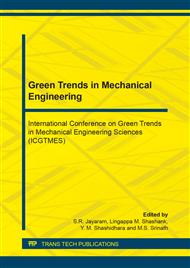p.230
p.237
p.244
p.253
p.259
p.265
p.272
p.278
p.284
Characterization of Cobalt Based Microwave Clad Developed on SS-355
Abstract:
In the present work a detailed microstructural investigation of Cobalt based microwave cladding on S-355 stainless steel was carried out. The experimentations were carried out in a home based domestic microwave oven. This article clears the circumstances of clad formation during microwave hybrid heating. The solidification texture and grain structure of the developed clad scanning electron microscope (SEM) equipped with energy dispersive X-ray spectroscopy, and measurement of Vicker’s microhardness. Cobalt based clads developed with an approximate thickness of 1 mm without interfacial cracking. The microstructure of clad clearly illustrated excellent metallurgical bond with S-355 substrate and found dominantly fine cellular grains. Iron and cobalt were recognized inside the cells while chromium was ascertained segregated around the cell boundaries. The average microhardness of the cobalt based clad was observed in the range of 402±60 HV.
Info:
Periodical:
Pages:
259-264
Citation:
Online since:
November 2019
Authors:
Keywords:
Price:
Сopyright:
© 2019 Trans Tech Publications Ltd. All Rights Reserved
Share:
Citation:


